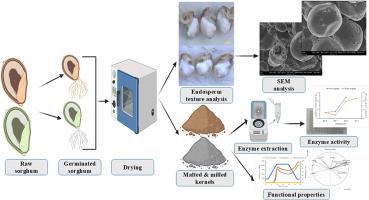麦化对1型非单宁高粱籽粒胚乳质地及麦芽粉功能特性的影响
IF 6.6
1区 农林科学
Q1 FOOD SCIENCE & TECHNOLOGY
引用次数: 0
摘要
研究了两种I型高粱(红色和白色表型)麦芽粉对胚乳质地和功能特性的影响。麦芽加工使两种高粱的胚乳从角质部变成粉状,可能是由于α-淀粉酶活性的增加。出芽的红高粱籽粒中面粉胚乳的比例高于白高粱籽粒。这可能是由于α-淀粉酶等水解酶的合成和活性增加,这些酶可以分解淀粉,为发芽的胚胎提供能量,最终提高了红高粱的萌发能。在发酵过程中,α-淀粉酶的活性增加了麦芽粉糊化过程中淀粉的含糖量,降低了淀粉的粘度,表明淀粉发生了解聚作用。淀粉的降解降低了它们在培养基中的吸水能力(吸水指数),增加了水溶性化合物(水溶性指数)。蛋白酶在消化淀粉周围的一些蛋白体和基质中的作用也可以增加淀粉对淀粉酶的可及性。麦芽加工是一种很有前途的绿色传统食品加工技术,可以在加工过程中提高高粱的最终使用质量。本文章由计算机程序翻译,如有差异,请以英文原文为准。

Effect of malting on endosperm texture of Type 1 non-tannin sorghum grains and functional properties of the malted flour
The effect of malting on endosperm texture and functional properties of the malted flour of two Type I sorghums (red and white phenotypes) was studied. Malting modified the endosperm of the two sorghums with a partial change from corneous to floury type, possibly due to the increased activity of α-amylase. The sprouted red sorghum grains appeared to have a higher proportion of floury endosperm than white sorghum grains. This could be attributed to the increased synthesis and activity of hydrolytic enzymes, such as α-amylase, which break down starch to provide energy for the germinating embryo, ultimately boosting the germinative energy of red sorghum. The α-amylase activity triggered during malting increased the sugar content and decreased the viscosity of starch during the pasting of the malted flour, suggesting starch depolymerisation. The degradation of starch decreased their ability to absorb water (water absorption index) and increased water-soluble compounds (water solubility index) in the medium. The action of protease enzymes in digesting some of the protein bodies and matrix surrounding the starch could also increase the accessibility of the starch to amylase enzymes. Malting is a promising green, traditional food processing technique to enhance the end-use quality of sorghum during processing.
求助全文
通过发布文献求助,成功后即可免费获取论文全文。
去求助
来源期刊

LWT - Food Science and Technology
工程技术-食品科技
CiteScore
11.80
自引率
6.70%
发文量
1724
审稿时长
65 days
期刊介绍:
LWT - Food Science and Technology is an international journal that publishes innovative papers in the fields of food chemistry, biochemistry, microbiology, technology and nutrition. The work described should be innovative either in the approach or in the methods used. The significance of the results either for the science community or for the food industry must also be specified. Contributions written in English are welcomed in the form of review articles, short reviews, research papers, and research notes. Papers featuring animal trials and cell cultures are outside the scope of the journal and will not be considered for publication.
 求助内容:
求助内容: 应助结果提醒方式:
应助结果提醒方式:


